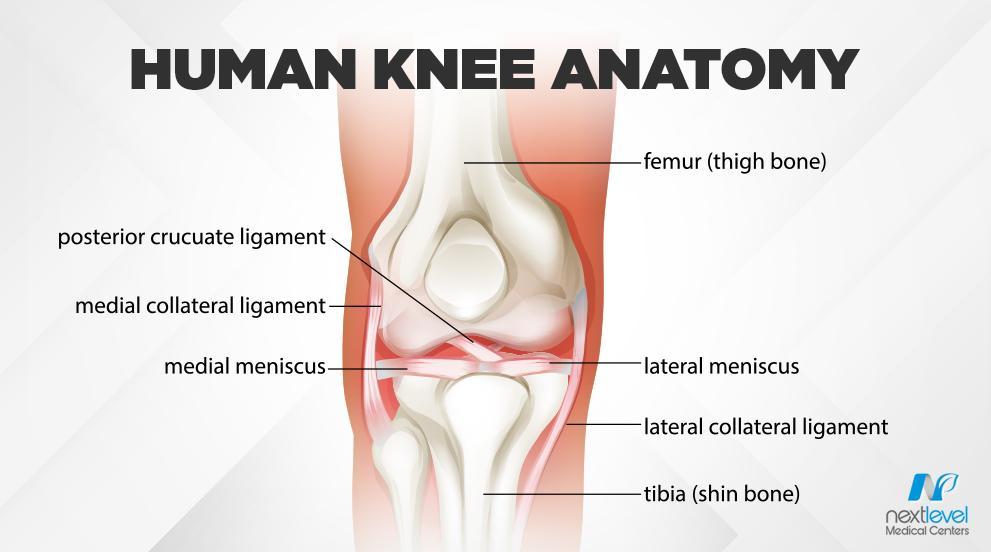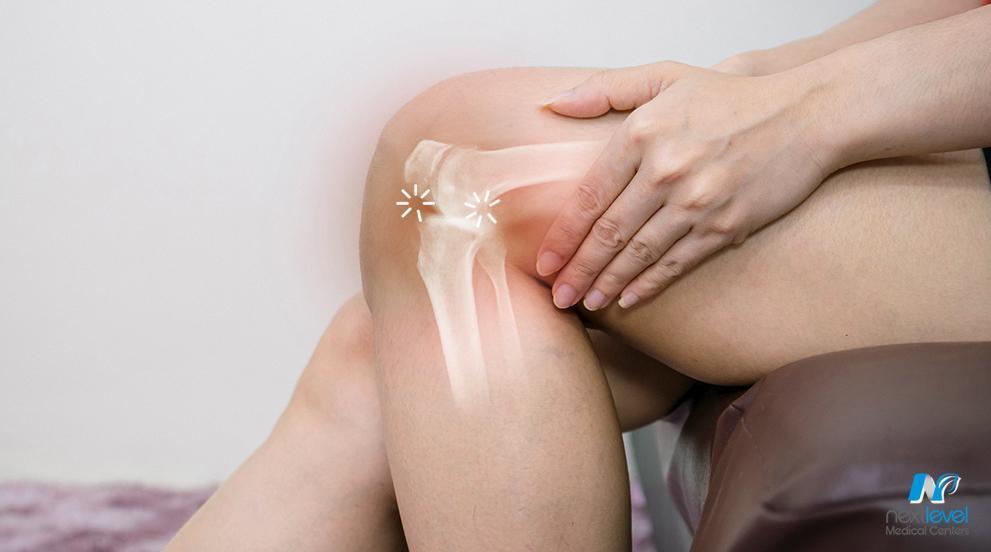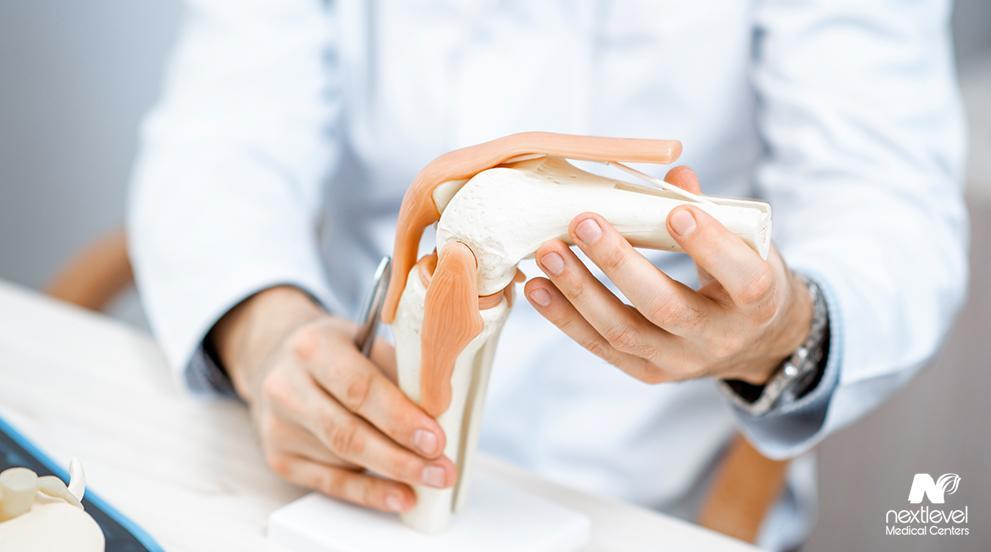We are constantly on the move, working our limbs to the limit as we go about our daily lives, and this inevitably leads to wear and tear that affects us physically. Unfortunately, knees take the brunt of the abuse and suffer worse damage. This constant wear can manifest itself in various ways that you might not have been aware of for the longest time. However, your body will eventually let you know when something is going on physically with specific symptoms, including an auditory cue like clicking.
If you are here, you have likely experienced a clicking noise when bending your knee that you do not remember being there before. We hope to inform you what causes this clicking and what it might mean with this article.
The Anatomy of the Knee
Your knee is to your leg as a hinge is to your bedroom door, albeit organic. It allows your knee to bend inwards to ensure motion and, like a hinge, will eventually wear down the more it is used. The knee itself is more complicated, though, involving harmonious cooperation of several anatomical components to keep the limb functional.
The structure of the knee involves connections between several leg bones required to maintain the joint’s function. The knee actually starts with the femur, the bone in your upper thigh, and connects to the tibia and fibula further down the leg. The kneecap is a separate bone, the patella, which shields the knee and is the main defense against injury. It’s also critical for your knee to bend.

However, the bones are not the only part of the knee that dictates its function. There are thick cushions of tissues called cartilage that reduce friction between the bones and keep them from rubbing against each other and damaging them. There are also four bands of flexible tissue called ligaments that connect the bones. Finally, the knee is lined with synovial tissue that uses synovial fluid to lubricate the joint to keep it moving smoothly.
Clearly, the human knee is a complex part of human anatomy, so it is no surprise that issues can arise within them. So, when you hear the clicking coming from your knee, it is often quite concerning. There can be any number of reasons responsible for the issue, so let’s dig in.
What is that Noise?
When your knees click, you likely wonder just what it is. Of course, there are many causes of the condition, but they all fall under one name: crepitus. Crepitus, also known as crepitation, is the medical word for any kind of clicking, grinding, grating, creaking, or other noises your joints can make. The word is Latin and comes from the word crepare, which means “rattle.”
What Causes Crepitus?
The symptom of clicking noises from your knee, otherwise known as crepitus, is a common issue with a long list of potential causes. Unfortunately, the clicking sound is usually little more than a symptom of a more significant issue that may or may not be severe, depending on which one is afflicting you. However, crepitus is not necessarily a cause for concern and can occasionally be resolved with little issue in the long run. However, more serious causes of crepitus can leave you with a more urgent journey ahead of you.
One of the most common causes of crepitus is also the most harmless and is not a cause for concern. Throughout everyone’s life, they will experience crepitus due to a buildup of gas between their joints. You might be wondering how gas could form between your joints, and the answer lies in one of the essential components of your knee’s physiology. The synovial fluid between your joints is prone to gas bubbles forming within it and, when you bend your knee, you are popping these gas bubbles and causing the clicking noise.

The gas bubbles in synovial fluid are completely harmless and do not induce pain. Popping them is equally harmless and is something you have likely done multiple times in the past if you are the sort of person who cracks their knuckles. The act of cracking your knuckles is exactly the same as popping the gas bubbles in the fluid in your knee joints.
The next possible cause of crepitus is patellofemoral instability, which is entirely out of your control. No one will have the same anatomy as someone else since life gives us form, and we are prone to minor variations. In some cases, this means that some part of your knee is formed differently, and your patella is off-center or unstable and, as a result, flexes out further than it usually should.
This flexing causes crepitus as your patella flexes out and brushes against other parts of your anatomy. Patellofemoral instability is unique in that it is the only one that can either be innocuous or cause long-term issues.
Another cause of the clicking noise from your knee bending is a little more severe but only really requires attention if it persists. This cause is when the ligaments stretch out further than they are meant to and pass over lumps of bone when settling back into place. If this is the cause of the knee clicking, it only becomes serious if it happens regularly. However, constant passes over bony lumps can cause internal damage that can lead to more severe issues arising as a result.
If you hear the clicking and simultaneously experience discomfort or pain, you might need to consult with a physician to ensure that you are not dealing with significant issues. However, even ligament issues are not necessarily severe if infrequent. Crepitus is a common occurrence and is generally not something you need to worry about. However, this is not always the case, as crepitus can be a symptom of a larger issue with your physical health.
Crepitus Caused by Injuries
While crepitus can be a natural occurrence due to general wear and tear as you live everyday life, it is not always that simple. Crepitus can be induced due to external stimuli inflicting severe damage to your knee and causing the cracking to begin. Physical trauma can be severe enough that your knee is damaged to the point of your kneecap no longer being in place or even shattering. If you have suffered a major injury or heavy physical trauma to your leg, any subsequent crepitus can indicate specific damage in your leg.
One of the first kinds of damage that crepitus can indicate are meniscus tears. The meniscus is part of the cartilage in your leg between the femur and tibia, and severe enough damage can cause this cartilage to tear and expose the bones to rubbing against each other. The crepitus results from the joints moving and rubbing against each other, chipping away at one another, and causing severe pain and irritation. Ordinarily, athletes are at higher risk of meniscus tears, but ultimately any excessive physical trauma can lead to these tears.

Another type of damage indicated by crepitus is patellofemoral syndrome, colloquially referred to as ‘runner’s knee,’ which is a condition that arises from excessive pressure being applied to the patella (kneecap). This sort of damage leads to cracking of the patella’s surface, and any crepitus is the sound of your kneecap crunching or grating against bone when you move it. Runner’s knee can be an excruciating injury to sustain, and the associated crepitus can be your sole indicator beyond the pain you have suffered from it.
Finally, crepitus can be indicative of chondromalacia patella. This type of damage affects the cartilage beneath the skin covering your patella. This crepitus might be accompanied by an ache behind your kneecap and is generally caused by overuse or injury to the knee. Crepitus and injury are common bedfellows, and they can serve as an excellent clue that you have suffered severe damage after enduring physical trauma to your knee. However, this is still not the end of what crepitus can mean, and yet another condition causes the clicking noises you hear.
Crepitus Caused by Arthritis
Unfortunately, crepitus is a common companion of the crippling condition called osteoarthritis. Osteoarthritis is a highly detrimental condition that generally begins manifesting in individuals aged 50 or older but can begin at any age.
Considered the ultimate wear and tear condition, osteoarthritis involves the degeneration of your joints. It can make everyday activities extremely painful or downright impossible, depending on the severity of the condition. Crepitus can indicate that osteoarthritis is an issue you are currently facing.

Osteoarthritis causes the cartilage in your joints to break down over time, resulting in severe pain and inflammation. This loss of cartilage results in the crepitus manifesting as the bones in your leg rub against each other and induce the clicking sounds you hear.
With osteoarthritis, crepitus can be an extremely painful sensation which makes the entire situation even more unpleasant than it otherwise should be. If you are experiencing this severe pain alongside the standard crepitus symptom, you should seek out care from your primary care physician to confirm or disprove the potential diagnosis. While crepitus is generally caused by conditions like osteoarthritis or severe trauma to the leg, one last thing can lead to persistent crepitus symptoms.
Crepitus Caused by Surgery
Sometimes, we need healing that our bodies are incapable of providing due to the physical limitations of the human experience. To combat this, modern medicine uses surgical procedures that allow us to recover from severe injuries and conditions that we cannot recover from naturally. Among these surgical procedures, knee replacement surgeries are used to compensate for severely damaged bones in the leg. Unfortunately, knee replacement surgery can be just as much of a cause of crepitus as any conditions we have discussed so far.

With surgery, crepitus generally occurs from several factors that arise from artificially replacing natural components of our physiology. In some cases, the minor shift to the alignment of the bones following surgery is the cause of post-op crepitus. In other cases, it is the replacement itself causing the sounds as the metal parts of the artificial piece clash with the natural bone. In most cases, the crepitus was already present but much quieter before installing a hunk of metal in your leg.
The last thing anyone ever wants to hear after surgery is a clicking sound coming from where a doctor was altering in some way or another. So, crepitus following surgery is probably a terrifying prospect. In most cases, however, crepitus after surgery is innocuous and little more than a mere auditory nuisance. However, even this can be caused to seek out an alternative to surgery if you need medical intervention for a condition in your leg.
Wrapping Up
Crepitus is an extremely common experience, more so than you might realize if yours is the result of synovial gas buildup. In most cases, it is harmless, if annoying, but is not cause for concern. However, in other cases, your body lets you know that something within your anatomy is amiss and that you should seek treatment of some sort.
The simple reality is that crepitus should only be cause for concern when accompanied by pain, irritation, or general discomfort since the painless variant is almost universally harmless. However, you should also consider seeking medical evaluation if the crepitus started immediately following a severe physical trauma since that might indicate the injury being the cause.

Simply put, crepitus has multiple potential causes that range from irrelevant to severely urgent. The only way to be entirely sure that the crepitus you are experiencing is an issue is to consult with your primary care physician and see what they say. After that, it just becomes a matter of following the appropriate treatment plan best for your recovery if it requires treatment. As always, we urge you to consult with your physician and live a happy and healthy life as you take your health to the Next Level. If you have any questions or concerns regarding crepitus, please feel free to reach out and contact us at any time.


